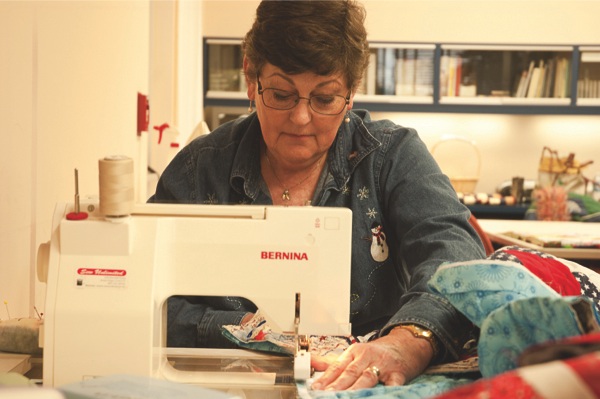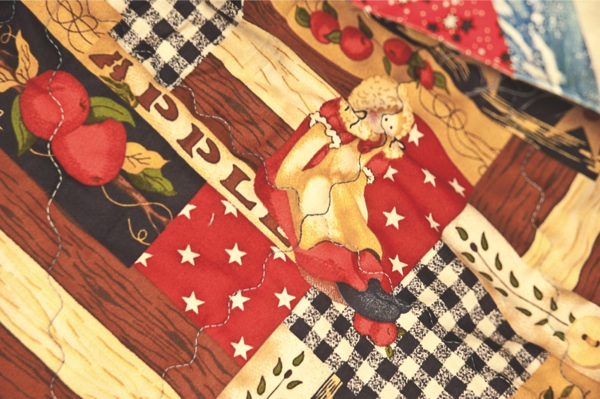SUN CITY – Remember Linus from the Charles Schultz comic “Charlie Brown”? Liss Kundich (N.21) surely does. He was the character who always carried around a blanket for security. Knowing how much a blanket can mean to a child, Project Linus was formed, and today, children in hospitals are the happy recipients of beautiful quilts. Liss was part of the Project Linus chapter in California before she moved to Illinois. She is now active in the Northbrook chapter. From the year 2002 until present day, they have made 6,500 quilts. Project Linus is a not-for-profit group.

Originally from occupied Denmark, Sun City resident Liss Kundich turns the hobby of quilting into a selfless act of humanity, making and sewing hundreds of quilts with groups such as Project Linus for those in need all over the world. (Photo by Chris LaPelusa/Sun Day)
Liss is a very busy lady, involved in four different quilting groups around the western suburbs: Gazebo Quilters in Huntley, the Prairie Points at the Community Church, and the Sew-n-Sews at Sun City, besides the Project Linus group in Northbrook.
The Northbrook group has just been asked to donate 100 quilts every two months to the University of Illinois for the children’s hospital there.
Liss quips, “First it was an interest, then a passion, and now it’s an addiction.”
She has about five or six quilts that she’s working on most of the time. Liss is pretty much self-taught, as she would read magazines such as Ladies Home Journal and watch quilting programs on PBS.

Liss is from Denmark, and when she was a little girl, (Denmark was an occupied country), her family received a Care Package from the Red Cross in America for the school children.
She was so taken with our generosity that she announced, “Someday, I’m going there!” The Red Cross planted a seed in her mind, and she thought, “Those people are really nice.” She realized how much it meant to give and to help others.
After living in California, she and her husband moved to Sun City about eight years ago, “because of the grandchildren.” And, yes, she is also teaching her granddaughters and grandsons to quilt.

Kundich displays an album full of photos of people who have benefitted from her quilts around the world. (Photo by Chris LaPelusa/Sun Day)
“I started a quilt for my nine-year-old grandson, and he finished it. He is so proud of it.”
Liss continued, “My granddaughters, ages six and eight, have made small quilts. I laid out the blocks for them. And my twelve-year-old likes nine patches [nine pieces to a square]. She makes lots of them, and someday it will be a quilt.”
Quilting began early for Liss as well.
Liss laughed in fond remembrance, “Back in the 50s and 60s, I arrived at church about a half hour before choir practice, and I heard laughter down the hall. I checked it out, and a Mrs. Ford invited me to join them. [It was a quilting group.] She showed me how to quilt, and I made a few stitches on this one quilt. Turns out that quilt was the one they gave me as a bridal shower gift. I’m sure they took out my stitches and redid it.”
Also while in California, “I made quilts for a children’s camp sponsored by Paul Newman. The camp was called The Painted Turtle. It was part of the Hole in the Wall Gang and was also supporting Childhood Protective Services.”
In 2008, Liss was the co-chairman of the Diplomacy Quilts for Afghanistan, and in that year, they sent 813 quilts to Afghanistan for the people. The quilts were pieced, sewn, and machine stitched.
“We don’t hand-quilt, as it takes too much time.”
Most of the materials that are used to make the quilts are donated by Material Girl in Crystal Lake, Touch of Amish in Barrington, Judy’s from Hampshire, and Quilt In Joy in Huntley.
“Our biggest expense is the batting, and the postage is by donation,” Liss added.
One of the local police officers was deployed to Afghanistan, and after two months of training, Liss received a call from him telling her they needed quilts for the children over there. So her group went to work and have sent several quilts so far.
Liss has won many prizes and designs many of the quilts she creates. In 2009, there was a competition to create the “Rose for Diana” to commemorate Princess Diana in a ceremony that was held in Santa Maria, California. Liss came in third out of several hundred submissions. She’s won prizes at county fairs and has done trunk shows and conducted lectures.
She refers to her quilting groups as “a sisterhood where we value socialization. It’s a whole lot cheaper than a psychiatrist. Most of us are transplants.”




